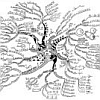| |
|
| |
 
Steven Kelk and
Celine Scornavacca. Constructing minimal phylogenetic networks from softwired clusters is fixed parameter tractable. In ALG, Vol. 68(4):886-915, 2014.
Keywords: explicit network, FPT, from clusters, level k phylogenetic network, phylogenetic network, phylogeny, reconstruction.
Note: http://arxiv.org/abs/1108.3653.
Toggle abstract
"Here we show that, given a set of clusters C on a set of taxa X, where |X|=n, it is possible to determine in time f(k)×poly(n) whether there exists a level-≤k network (i.e. a network where each biconnected component has reticulation number at most k) that represents all the clusters in C in the softwired sense, and if so to construct such a network. This extends a result from Kelk et al. (in IEEE/ACM Trans. Comput. Biol. Bioinform. 9:517-534, 2012) which showed that the problem is polynomial-time solvable for fixed k. By defining "k-reticulation generators" analogous to "level-k generators", we then extend this fixed parameter tractability result to the problem where k refers not to the level but to the reticulation number of the whole network. © 2012 Springer Science+Business Media New York."
|
|
| |
|
| |
   
Johann-Mattis List,
Shijulal Nelson-Sathi,
Hans Geisler and
William Martin. Networks of lexical borrowing and lateral gene transfer in language and genome evolution. In BioEssays, Vol. 36(2):141-150, 2014.
Keywords: explicit network, minimal lateral network, phylogenetic network, Program lingpy.
Note: http://dx.doi.org/10.1002/bies.201300096.
Toggle abstract
"Like biological species, languages change over time. As noted by Darwin, there are many parallels between language evolution and biological evolution. Insights into these parallels have also undergone change in the past 150 years. Just like genes, words change over time, and language evolution can be likened to genome evolution accordingly, but what kind of evolution? There are fundamental differences between eukaryotic and prokaryotic evolution. In the former, natural variation entails the gradual accumulation of minor mutations in alleles. In the latter, lateral gene transfer is an integral mechanism of natural variation. The study of language evolution using biological methods has attracted much interest of late, most approaches focusing on language tree construction. These approaches may underestimate the important role that borrowing plays in language evolution. Network approaches that were originally designed to study lateral gene transfer may provide more realistic insights into the complexities of language evolution. Editor's suggested further reading in BioEssays Linguistic evidence supports date for Homeric epics. © 2014 The Authors. BioEssays Published by WILEY Periodicals, Inc."
|
|
| |
|
| |
  
Paul Cordue,
Simone Linz and
Charles Semple. Phylogenetic Networks that Display a Tree Twice. In BMB, Vol. 76(10):2664-2679, 2014.
Keywords: from rooted trees, normal network, phylogenetic network, phylogeny, reconstruction, tree-child network.
Note: http://www.math.canterbury.ac.nz/~c.semple/papers/CLS14.pdf.
Toggle abstract
"In the last decade, the use of phylogenetic networks to analyze the evolution of species whose past is likely to include reticulation events, such as horizontal gene transfer or hybridization, has gained popularity among evolutionary biologists. Nevertheless, the evolution of a particular gene can generally be described without reticulation events and therefore be represented by a phylogenetic tree. While this is not in contrast to each other, it places emphasis on the necessity of algorithms that analyze and summarize the tree-like information that is contained in a phylogenetic network. We contribute to the toolbox of such algorithms by investigating the question of whether or not a phylogenetic network embeds a tree twice and give a quadratic-time algorithm to solve this problem for a class of networks that is more general than tree-child networks. © 2014, Society for Mathematical Biology."
|
|
| |
 
Jialiang Yang,
Stefan Grünewald,
Yifei Xu and
Xiu-Feng Wan. Quartet-based methods to reconstruct phylogenetic networks. In BMC Systems Biology, Vol. 80(21), 2014.
Keywords: abstract network, from quartets, phylogenetic network, phylogeny, Program QuartetMethods, Program QuartetNet, Program SplitsTree, reconstruction.
Note: http://dx.doi.org/10.1186/1752-0509-8-21
.
Toggle abstract
"Background: Phylogenetic networks are employed to visualize evolutionary relationships among a group of nucleotide sequences, genes or species when reticulate events like hybridization, recombination, reassortant and horizontal gene transfer are believed to be involved. In comparison to traditional distance-based methods, quartet-based methods consider more information in the reconstruction process and thus have the potential to be more accurate.Results: We introduce QuartetSuite, which includes a set of new quartet-based methods, namely QuartetS, QuartetA, and QuartetM, to reconstruct phylogenetic networks from nucleotide sequences. We tested their performances and compared them with other popular methods on two simulated nucleotide sequence data sets: one generated from a tree topology and the other from a complicated evolutionary history containing three reticulate events. We further validated these methods to two real data sets: a bacterial data set consisting of seven concatenated genes of 36 bacterial species and an influenza data set related to recently emerging H7N9 low pathogenic avian influenza viruses in China.Conclusion: QuartetS, QuartetA, and QuartetM have the potential to accurately reconstruct evolutionary scenarios from simple branching trees to complicated networks containing many reticulate events. These methods could provide insights into the understanding of complicated biological evolutionary processes such as bacterial taxonomy and reassortant of influenza viruses. © 2014 Yang et al.; licensee BioMed Central Ltd."
|
|
| |
   
Leo van Iersel,
Steven Kelk,
Nela Lekic and
Celine Scornavacca. A practical approximation algorithm for solving massive instances of hybridization number for binary and nonbinary trees. In BMCB, Vol. 15(127):1-12, 2014.
Keywords: agreement forest, approximation, explicit network, from rooted trees, phylogenetic network, phylogeny, Program CycleKiller, Program TerminusEst, reconstruction.
Note: http://dx.doi.org/10.1186/1471-2105-15-127.
|
|
| |

Ward C Wheeler. Phyletic groups on networks. In Cladistics, Vol. 30(4):447-451, 2014.
Keywords: explicit network, from network, phylogenetic network, phylogeny.
Note: http://dx.doi.org/10.1111/cla.12062.
Toggle abstract
"Three additional phyletic group types, "periphyletic," "epiphyletic", and "anaphyletic" (in addition to Hennigian mono-, para-, and polyphyletic) are defined in terms of trees and phylogenetic networks (trees with directed reticulate edges) via a generalization of the algorithmic definitions of Farris. These designations concern groups defined as monophyletic on trees, but with additional gains or losses of members from network edges. These distinctions should be useful in discussion of systems with non-vertical inheritance such as recombination between viruses, horizontal exchange between bacteria, hybridization in plants and animals, as well as human linguistic evolution. Examples are illustrated with Indo-European language groups. © The Willi Hennig Society 2013."
|
|
| |
|
| |
|
| |
   
Adrià Alcalà Mena,
Mercè Llabrés,
Francesc Rosselló and
Pau Rullan. Tree-Child Cluster Networks. In Fundamenta Informaticae, Vol. 134(1-2):1-15, 2014.
Keywords: explicit network, from clusters, phylogenetic network, phylogeny, Program PhyloNetwork, reconstruction, tree-child network.
|
|
| |

Juan Wang. A new algorithm to construct phylogenetic networks from trees. In Genetics and Molecular Research, Vol. 13(1):1456-1464, 2014.
Keywords: explicit network, from clusters, heuristic, phylogenetic network, Program LNetwork, Program QuickCass, reconstruction.
Note: http://dx.doi.org/10.4238/2014.March.6.4.
Toggle abstract
"Developing appropriate methods for constructing phylogenetic networks from tree sets is an important problem, and much research is currently being undertaken in this area. BIMLR is an algorithm that constructs phylogenetic networks from tree sets. The algorithm can construct a much simpler network than other available methods. Here, we introduce an improved version of the BIMLR algorithm, QuickCass. QuickCass changes the selection strategy of the labels of leaves below the reticulate nodes, i.e., the nodes with an indegree of at least 2 in BIMLR. We show that QuickCass can construct simpler phylogenetic networks than BIMLR. Furthermore, we show that QuickCass is a polynomial-time algorithm when the output network that is constructed by QuickCass is binary. © FUNPEC-RP."
|
|
| |
  
Sarah Bastkowski,
Andreas Spillner and
Vincent Moulton. Fishing for minimum evolution trees with Neighbor-Nets. In IPL, Vol. 114(1-2):3-18, 2014.
Keywords: circular split system, from distances, NeighborNet, phylogeny, polynomial.
Toggle abstract
"In evolutionary biology, biologists commonly use a phylogenetic tree to represent the evolutionary history of some set of species. A common approach taken to construct such a tree is to search through the space of all possible phylogenetic trees on the set so as to find one that optimizes some score function, such as the minimum evolution criterion. However, this is hampered by the fact that the space of phylogenetic trees is extremely large in general. Interestingly, an alternative approach, which has received somewhat less attention in the literature, is to instead search for trees within some set of bipartitions or splits of the set of species in question. Here we consider the problem of searching through a set of splits that is circular. Such sets can, for example, be generated by the NeighborNet algorithm for constructing phylogenetic networks. More specifically, we present an O(n4) time algorithm for finding an optimal minimum evolution tree in a circular set of splits on a set of species of size n. In addition, using simulations, we compare the performance of this algorithm when applied to NeighborNet output with that of FastME, a leading method for searching for minimum evolution trees in tree space. We find that, even though a circular set of splits represents just a tiny fraction of the total number of possible splits of a set, the trees obtained from circular sets compare quite favorably with those obtained with FastME, suggesting that the approach could warrant further investigation. © 2013 Elsevier B.V."
|
|
| |
  
Matthieu Willems,
Nadia Tahiri and
Vladimir Makarenkov. A new efficient algorithm for inferring explicit hybridization networks following the Neighbor-Joining principle. In JBCB, Vol. 12(5), 2014.
Keywords: explicit network, from distances, heuristic, phylogenetic network, phylogeny, reconstruction.
Toggle abstract
"Several algorithms and software have been developed for inferring phylogenetic trees. However, there exist some biological phenomena such as hybridization, recombination, or horizontal gene transfer which cannot be represented by a tree topology. We need to use phylogenetic networks to adequately represent these important evolutionary mechanisms. In this article, we present a new efficient heuristic algorithm for inferring hybridization networks from evolutionary distance matrices between species. The famous Neighbor-Joining concept and the least-squares criterion are used for building networks. At each step of the algorithm, before joining two given nodes, we check if a hybridization event could be related to one of them or to both of them. The proposed algorithm finds the exact tree solution when the considered distance matrix is a tree metric (i.e. it is representable by a unique phylogenetic tree). It also provides very good hybrids recovery rates for large trees (with 32 and 64 leaves in our simulations) for both distance and sequence types of data. The results yielded by the new algorithm for real and simulated datasets are illustrated and discussed in detail. © Imperial College Press."
|
|
| |
 
Lavanya Kannan and
Ward C Wheeler. Exactly Computing the Parsimony Scores on Phylogenetic Networks Using Dynamic Programming. In JCB, Vol. 21(4):303-319, 2014.
Keywords: explicit network, exponential algorithm, from network, from sequences, parsimony, phylogenetic network, phylogeny, reconstruction.
Toggle abstract
"Scoring a given phylogenetic network is the first step that is required in searching for the best evolutionary framework for a given dataset. Using the principle of maximum parsimony, we can score phylogenetic networks based on the minimum number of state changes across a subset of edges of the network for each character that are required for a given set of characters to realize the input states at the leaves of the networks. Two such subsets of edges of networks are interesting in light of studying evolutionary histories of datasets: (i) the set of all edges of the network, and (ii) the set of all edges of a spanning tree that minimizes the score. The problems of finding the parsimony scores under these two criteria define slightly different mathematical problems that are both NP-hard. In this article, we show that both problems, with scores generalized to adding substitution costs between states on the endpoints of the edges, can be solved exactly using dynamic programming. We show that our algorithms require O(mpk) storage at each vertex (per character), where k is the number of states the character can take, p is the number of reticulate vertices in the network, m = k for the problem with edge set (i), and m = 2 for the problem with edge set (ii). This establishes an O(nmpk2) algorithm for both the problems (n is the number of leaves in the network), which are extensions of Sankoff's algorithm for finding the parsimony scores for phylogenetic trees. We will discuss improvements in the complexities and show that for phylogenetic networks whose underlying undirected graphs have disjoint cycles, the storage at each vertex can be reduced to O(mk), thus making the algorithm polynomial for this class of networks. We will present some properties of the two approaches and guidance on choosing between the criteria, as well as traverse through the network space using either of the definitions. We show that our methodology provides an effective means to study a wide variety of datasets. © Copyright 2014, Mary Ann Liebert, Inc. 2014."
|
|
| |
|
| |
 
Leo van Iersel and
Vincent Moulton. Trinets encode tree-child and level-2 phylogenetic networks. In JOMB, Vol. 68(7):1707-1729, 2014.
Keywords: explicit network, from subnetworks, from trinets, level k phylogenetic network, phylogenetic network, phylogeny, reconstruction.
Note: http://arxiv.org/abs/1210.0362.
Toggle abstract
"Phylogenetic networks generalize evolutionary trees, and are commonly used to represent evolutionary histories of species that undergo reticulate evolutionary processes such as hybridization, recombination and lateral gene transfer. Recently, there has been great interest in trying to develop methods to construct rooted phylogenetic networks from triplets, that is rooted trees on three species. However, although triplets determine or encode rooted phylogenetic trees, they do not in general encode rooted phylogenetic networks, which is a potential issue for any such method. Motivated by this fact, Huber and Moulton recently introduced trinets as a natural extension of rooted triplets to networks. In particular, they showed that level-1 phylogenetic networks are encoded by their trinets, and also conjectured that all "recoverable" rooted phylogenetic networks are encoded by their trinets. Here we prove that recoverable binary level-2 networks and binary tree-child networks are also encoded by their trinets. To do this we prove two decomposition theorems based on trinets which hold for all recoverable binary rooted phylogenetic networks. Our results provide some additional evidence in support of the conjecture that trinets encode all recoverable rooted phylogenetic networks, and could also lead to new approaches to construct phylogenetic networks from trinets. © 2013 Springer-Verlag Berlin Heidelberg."
|
|
| |
 
Jesper Jansson and
Andrzej Lingas. Computing the rooted triplet distance between galled trees by counting triangles. In Journal of Discrete Algorithms, Vol. 25:66-78, 2014.
Keywords: distance between networks, explicit network, from network, galled network, phylogenetic network, phylogeny, polynomial, triplet distance.
Toggle abstract
"We consider a generalization of the rooted triplet distance between two phylogenetic trees to two phylogenetic networks. We show that if each of the two given phylogenetic networks is a so-called galled tree with n leaves then the rooted triplet distance can be computed in o(n2.687) time. Our upper bound is obtained by reducing the problem of computing the rooted triplet distance between two galled trees to that of counting monochromatic and almost-monochromatic triangles in an undirected, edge-colored graph. To count different types of colored triangles in a graph efficiently, we extend an existing technique based on matrix multiplication and obtain several new algorithmic results that may be of independent interest: (i) the number of triangles in a connected, undirected, uncolored graph with m edges can be computed in o(m1.408) time; (ii) if G is a connected, undirected, edge-colored graph with n vertices and C is a subset of the set of edge colors then the number of monochromatic triangles of G with colors in C can be computed in o(n2.687) time; and (iii) if G is a connected, undirected, edge-colored graph with n vertices and R is a binary relation on the colors that is computable in O(1) time then the number of R-chromatic triangles in G can be computed in o(n2.687) time. © 2013 Elsevier B.V. All rights reserved."
|
|
| |
  
Hadi Poormohammadi,
Changiz Eslahchi and
Ruzbeh Tusserkani. TripNet: A Method for Constructing Rooted Phylogenetic Networks from Rooted Triplets. In PLoS ONE, Vol. 9(9):e106531, 2014.
Keywords: explicit network, from triplets, heuristic, level k phylogenetic network, phylogenetic network, phylogeny, Program TripNet, reconstruction, software.
Note: http://arxiv.org/abs/1201.3722.
Toggle abstract
"The problem of constructing an optimal rooted phylogenetic network from an arbitrary set of rooted triplets is an NP-hard problem. In this paper, we present a heuristic algorithm called TripNet, which tries to construct a rooted phylogenetic network with the minimum number of reticulation nodes from an arbitrary set of rooted triplets. Despite of current methods that work for dense set of rooted triplets, a key innovation is the applicability of TripNet to non-dense set of rooted triplets. We prove some theorems to clarify the performance of the algorithm. To demonstrate the efficiency of TripNet, we compared TripNet with SIMPLISTIC. It is the only available software which has the ability to return some rooted phylogenetic network consistent with a given dense set of rooted triplets. But the results show that for complex networks with high levels, the SIMPLISTIC running time increased abruptly. However in all cases TripNet outputs an appropriate rooted phylogenetic network in an acceptable time. Also we tetsed TripNet on the Yeast data. The results show that Both TripNet and optimal networks have the same clustering and TripNet produced a level-3 network which contains only one more reticulation node than the optimal network."
|
|
| |
    
Kevin J. Liu,
Jingxuan Dai,
Kathy Truong,
Ying Song,
Michael H. Kohn and
Luay Nakhleh. An HMM-Based Comparative Genomic Framework for Detecting Introgression in Eukaryotes. In PLoS ONE, Vol. 10(6):e1003649, 2014.
Keywords: explicit network, from network, phylogenetic network, phylogeny, Program PhyloNet-HMM.
Note: http://arxiv.org/abs/1310.7989.
Toggle abstract
"One outcome of interspecific hybridization and subsequent effects of evolutionary forces is introgression, which is the integration of genetic material from one species into the genome of an individual in another species. The evolution of several groups of eukaryotic species has involved hybridization, and cases of adaptation through introgression have been already established. In this work, we report on PhyloNet-HMM-a new comparative genomic framework for detecting introgression in genomes. PhyloNet-HMM combines phylogenetic networks with hidden Markov models (HMMs) to simultaneously capture the (potentially reticulate) evolutionary history of the genomes and dependencies within genomes. A novel aspect of our work is that it also accounts for incomplete lineage sorting and dependence across loci. Application of our model to variation data from chromosome 7 in the mouse (Mus musculus domesticus) genome detected a recently reported adaptive introgression event involving the rodent poison resistance gene Vkorc1, in addition to other newly detected introgressed genomic regions. Based on our analysis, it is estimated that about 9% of all sites within chromosome 7 are of introgressive origin (these cover about 13 Mbp of chromosome 7, and over 300 genes). Further, our model detected no introgression in a negative control data set. We also found that our model accurately detected introgression and other evolutionary processes from synthetic data sets simulated under the coalescent model with recombination, isolation, and migration. Our work provides a powerful framework for systematic analysis of introgression while simultaneously accounting for dependence across sites, point mutations, recombination, and ancestral polymorphism. © 2014 Liu et al."
|
|
| |
|
| |
   
Leo van Iersel,
Steven Kelk,
Nela Lekic and
Leen Stougie. Approximation algorithms for nonbinary agreement forests. In SIDMA, Vol. 28(1):49-66, 2014.
Keywords: agreement forest, approximation, from rooted trees, hybridization, minimum number, phylogenetic network, phylogeny, reconstruction.
Note: http://arxiv.org/abs/1210.3211.
Toggle abstract
"Given two rooted phylogenetic trees on the same set of taxa X, the Maximum Agreement Forest (maf) problem asks to find a forest that is, in a certain sense, common to both trees and has a minimum number of components. The Maximum Acyclic Agreement Forest (maaf) problem has the additional restriction that the components of the forest cannot have conflicting ancestral relations in the input trees. There has been considerable interest in the special cases of these problems in which the input trees are required to be binary. However, in practice, phylogenetic trees are rarely binary, due to uncertainty about the precise order of speciation events. Here, we show that the general, nonbinary version of maf has a polynomial-time 4-approximation and a fixedparameter tractable (exact) algorithm that runs in O(4opoly(n)) time, where n = |X| and k is the number of components of the agreement forest minus one. Moreover, we show that a c-approximation algorithm for nonbinary maf and a d-approximation algorithm for the classical problem Directed Feedback Vertex Set (dfvs) can be combined to yield a d(c+3)-approximation for nonbinary maaf. The algorithms for maf have been implemented and made publicly available. © 2014 Society for Industrial and Applied Mathematics."
|
|
| |
  
Monika Balvociute,
Andreas Spillner and
Vincent Moulton. FlatNJ: A Novel Network-Based Approach to Visualize Evolutionary and Biogeographical Relationships. In Systematic Biology, Vol. 63(3):383-396, 2014.
Keywords: abstract network, flat, phylogenetic network, phylogeny, Program FlatNJ, Program SplitsTree, split network.
Note: http://dx.doi.org/10.1093/sysbio/syu001.
Toggle abstract
"Split networks are a type of phylogenetic network that allow visualization of conflict in evolutionary data. We present a new method for constructing such networks called FlatNetJoining (FlatNJ). A key feature of FlatNJ is that it produces networks that can be drawn in the plane in which labels may appear inside of the network. For complex data sets that involve, for example, non-neutral molecular markers, this can allow additional detail to be visualized as compared to previous methods such as split decomposition and NeighborNet. We illustrate the application of FlatNJ by applying it to whole HIV genome sequences, where recombination has taken place, fluorescent proteins in corals, where ancestral sequences are present, and mitochondrial DNA sequences from gall wasps, where biogeographical relationships are of interest. We find that the networks generated by FlatNJ can facilitate the study of genetic variation in the underlying molecular sequence data and, in particular, may help to investigate processes such as intra-locus recombination. FlatNJ has been implemented in Java and is freely available at www.uea.ac.uk/computing/software/ flatnj. [flat split system; NeighborNet; Phylogenetic network; QNet; split; split network.] © The Author(s) 2014."
|
|
| |
     
Joel Sjöstrand,
Ali Tofigh,
Vincent Daubin,
Lars Arvestad,
Bengt Sennblad and
Jens Lagergren. A Bayesian Method for Analyzing Lateral Gene Transfer. In Systematic Biology, Vol. 63(3):409-420, 2014.
Keywords: bayesian, duplication, from rooted trees, from sequences, from species tree, lateral gene transfer, loss, phylogenetic network, phylogeny, Program JPrIME-DLTRS, reconstruction.
Note: http://dx.doi.org/10.1093/sysbio/syu007.
|
|
| |
|
| |
 
Anthony Labarre and
Sicco Verwer. Merging partially labelled trees: hardness and a declarative programming solution. In TCBB, Vol. 11(2):389-397, 2014.
Keywords: abstract network, from unrooted trees, heuristic, NP complete, phylogenetic network, phylogeny, reconstruction.
Note: https://hal-upec-upem.archives-ouvertes.fr/hal-00855669.
Toggle abstract
"Intraspecific studies often make use of haplotype networks instead of gene genealogies to represent the evolution of a set of genes. Cassens et al. proposed one such network reconstruction method, based on the global maximum parsimony principle, which was later recast by the first author of the present work as the problem of finding a minimum common supergraph of a set of t partially labelled trees. Although algorithms have been proposed for solving that problem on two graphs, the complexity of the general problem on trees remains unknown. In this paper, we show that the corresponding decision problem is NP-complete for t=3. We then propose a declarative programming approach to solving the problem to optimality in practice, as well as a heuristic approach, both based on the idpsystem, and assess the performance of both methods on randomly generated data. © 2004-2012 IEEE."
|
|
| |
   
Gabriel Cardona,
Mercè Llabrés,
Francesc Rosselló and
Gabriel Valiente. The comparison of tree-sibling time consistent phylogenetic networks is graph-isomorphism complete. In The Scientific World Journal, Vol. 2014(254279):1-6, 2014.
Keywords: abstract network, distance between networks, from network, isomorphism, phylogenetic network, tree sibling network.
Note: http://arxiv.org/abs/0902.4640.
Toggle abstract
"Several polynomial time computable metrics on the class of semibinary tree-sibling time consistent phylogenetic networks are available in the literature; in particular, the problem of deciding if two networks of this kind are isomorphic is in P. In this paper, we show that if we remove the semibinarity condition, then the problem becomes much harder. More precisely, we prove that the isomorphism problem for generic tree-sibling time consistent phylogenetic networks is polynomially equivalent to the graph isomorphism problem. Since the latter is believed not to belong to P, the chances are that it is impossible to define a metric on the class of all tree-sibling time consistent phylogenetic networks that can be computed in polynomial time. © 2014 Gabriel Cardona et al."
|
|
| |
|
| |
|
|